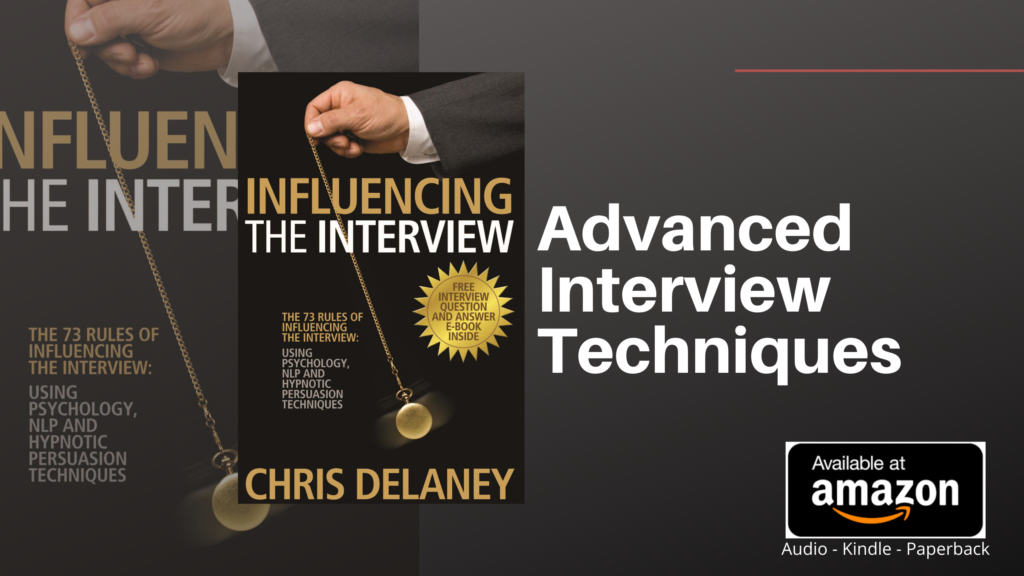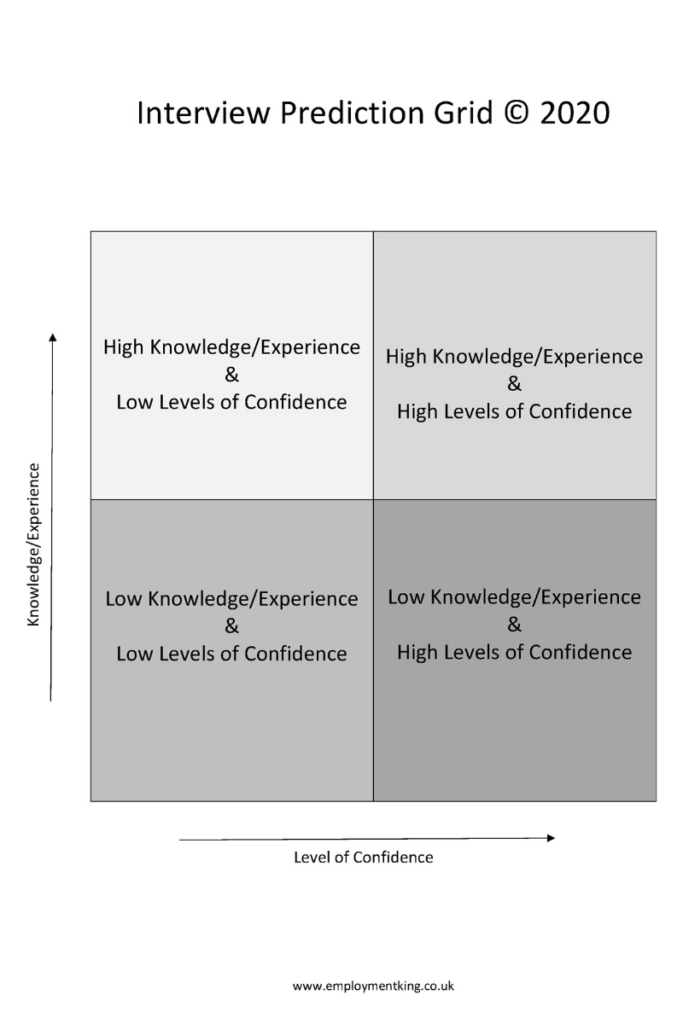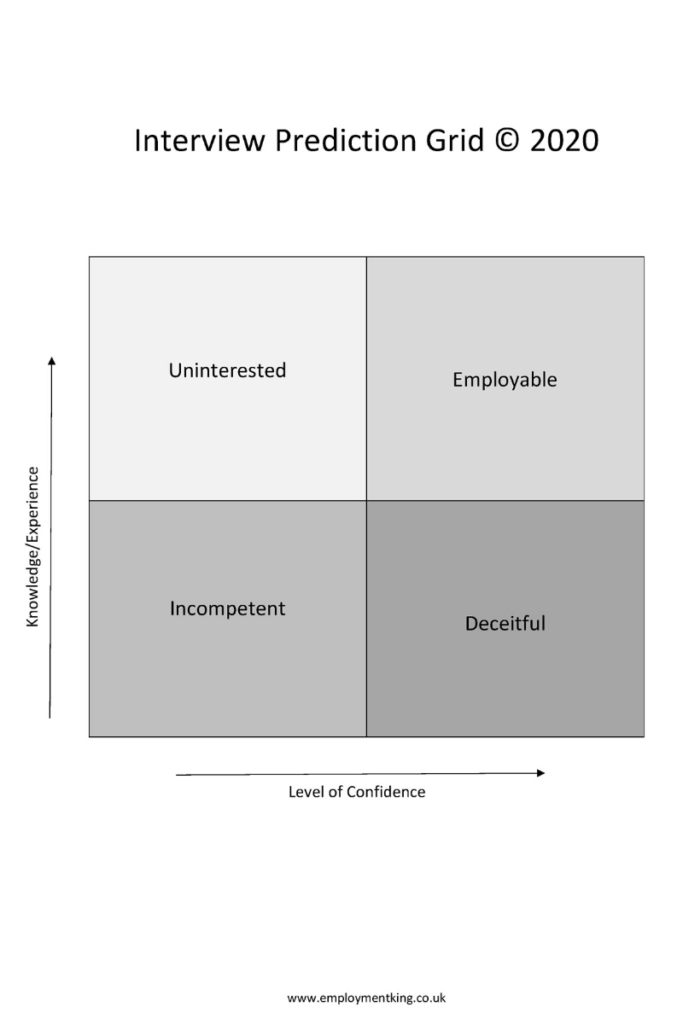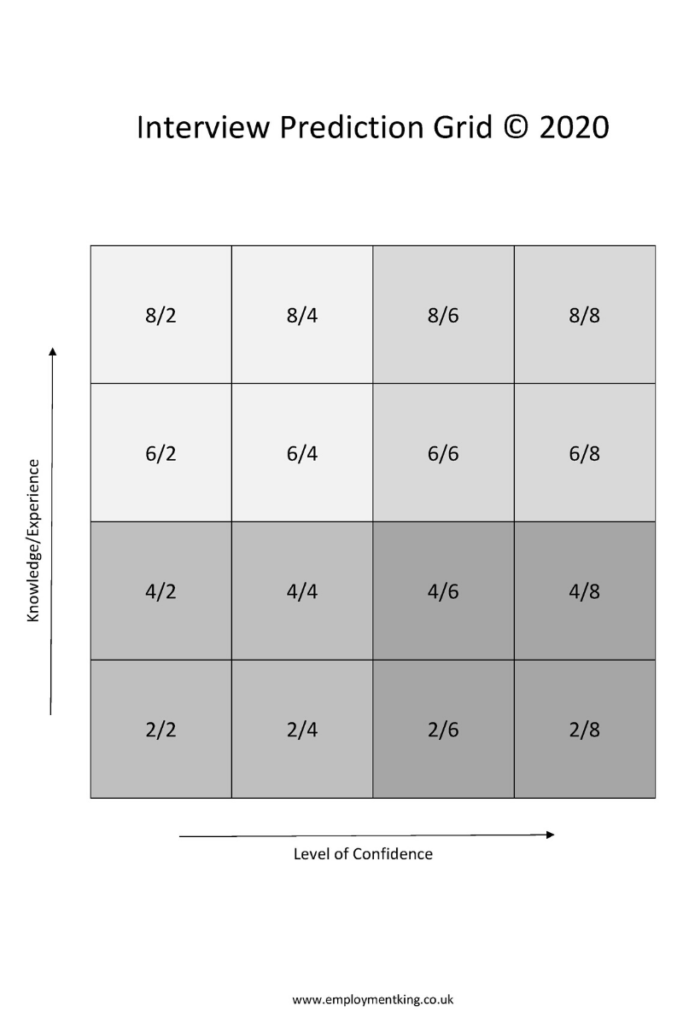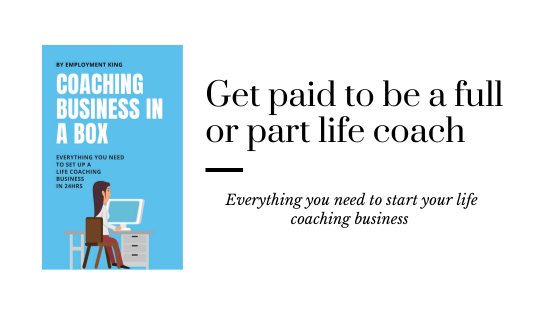Article Overview
The structured job interview is based on academic research to support organisations to recruit the most suitable applicant for an advertised role. Applicants knowing (or believing) they meet the job criteria and/or possess additional expertise (unique selling point) can still receive a high job interview fail rate, rarely gaining job offers.
The article, using the ‘Interview Prediction Grid’ (IPG) ©2020 model aims to support interviewees to understand the psychology of a job interview, including unconscious bias, and how the interviewee is perceived during the job interview process (their job interview identity) and therefore allowing the interviewee to improve how they communicate their competences and confidence with a view to increasing job offers.
Chapters and Shortcut Links:
Generic Overview of the Interview Prediction Grid Outcomes
Interview Prediction Grid Specific Outcome
Download a PDF version of this article here (no references): IPG No References
Structured Job Interview
In the main, organisations use the structured interview process as the principal intervention to make a decision on which applicant to offer an advertised position to. “The employment interview remains the most widely accepted method for employee selection” (Bernieri, Frank; 2000) Two key types of structured interviews include: behavioral interview and situational interview. “Structure has been defined as “the degree of discretion that an interviewer is allowed in conducting the interview and can accordingly be characterized by the degree of standardization of interview questions, interview administration and response scoring.” (Ingold et al., 2014)
In each structured interview, the interviewer will ask each candidate the same, on average, 6-10 job interview questions. “There are several variations to structured interviewing, all of which share a reliance on job analysis, consistent questioning, and anchored, numeric scoring.” (SIMONS, 1995). The interviewees’ replies are recorded and scored on an interview score sheet, with the quality of the answer being awarded a score based on a point system. “Suppose you are a front-desk manager and you have an idea for a change in reservations procedures to reduce errors, but there is a problem in that some members of your staff are against any type of change. What do you do in this situation? Excellent answers: “Explain the change and try to show the benefits’; and “Discuss it openly in a meeting’ Score — 5 Good answers: “Ask them why they are against change’; and “Try to convince them ” Score = 3 Marginal answer: “Fire them .’ Score = 1” (SIMONS, 1995) Post interview, the candidate’s interview question scores are collated and the highest scoring candidate, as long as the interviewee has met the minimum scoring benchmark, is offered the position.
The two types of structured interview questions; behavioral and situational, frame the interview question based on either past behaviours or potential actions for future situations. The goal here is to ensure the type of interview questions used support the interview panel to choose the ‘best’ candidate for the advertised job role. “When selecting employees, organizations can strive to select candidates who can or candidates who will do the best job.” (Klehe and Latham, 2006)
Which structured interview question is most suitable? “Based on the assumption that past behavior is the best predictor of future behavior, Janz (1989) argued that “the more long-standing the applicant’s behavior pattern in the past, the more likely it will predict behavior in the future.” (Klehe and Latham, 2006) But in a world where more career professionals job-hop, due to the changing landscape of job sectors, not all interviewees will have direct previous experience. “Behavioral questions, however, are of limited usefulness when candidates are not experienced at the type of job for which they are applying. This limitation in some cases might unfairly influence the interview performance of youthful or nontraditional candidates” (SIMONS, 1995)
By asking questions about a future scenario, the interviewer can gain an understanding of the applicant’s approach to situations, therefore identifying the interviewee’s relevant skills and abilities “Situational interviews take an approach similar to that of behavioral interviews, but the questions asked are hypothetical, future-oriented questions.” (SIMONS, 1995)
From the applicant’s perspective, to increase successful job interview outcomes, they need to be aware of how they are perceived by the employer and how this perception affects their interview performance. “We know, for example that the more an applicant is similar to the interviewer, the more highly the applicant will be rated higher on likable, competence, and confidence” (Bernieri, Frank; 2000)
Job Interview Evaluation
One means of evaluating the likely outcome of a successful structured job interview is via the ‘Interview Prediction Grid’ (IPG) ©2020
The interview prediction grid provides a basis to compare two equally required job interview criteria; sector knowledge/experience (KE) and level of confidence (LoC)
The decision of where an interviewee is placed on the ‘interview prediction grid’ needs to account for their behaviour in a job interview, not in the workplace. Environmental factors play a large part in the level of competence and confidence. “an implied assumption is most research on employment interviews is that interviewers assess, not provoke, applicant behaviour during interviews. Recent theoretical models (Jablin & McComb, 1984) and empirical work (eg Philips & Dipboye, 1989) suggest that interviewer behaviour may influence applicant behaviour” (Liden, Martin and Parsons, 1993)
In the workplace, an employee may possess high levels of sector knowledge and feel confident completing task(s), but if, in the job interview, they are unable to express their sector experience and competencies (as a result of interview stress or being interviewed by either a cold or expert interviewer) and/or lack job interview confidence, the job interview outcome will be based on this fiction, not the reality of the applicant’s real value in terms of what they can offer a new employer. “Considerable research has found that candidates who are anxious in the job interview receive significantly lower ratings of interview performance and are less likely to be hired for the job” (Powell, Deborah & Feiler, Amanda; 2015).
For job applicants with low knowledge/experience (this is often the case for graduate jobs/side moves/promotions/career changes) and/or low confidence (anxious individuals or those with low self-esteem) the ‘Interview Prediction Grid’ (IPG) ©2020 will give a realistic evaluation of the applicants worth from the employers perspective. “Although past research has criticized the interview process because interviewer evaluations do not predict supervisor ratings, promotion, training success or tenure, it is important to remember that the interview can not reflect how successful or unsuccessful the rejected candidates would have performed the job if hired.” (Bernieri, Frank; 2000)
Successful job interview applicants possess or are perceived to have high levels of sector knowledge/experience relevant to the position they are applying for, and high levels of confidence in a job interview environment. The combined score of KE vs LoC changes the interviewer’s perspective of the applicant, creating an ‘interview identity’. The perspective or ‘interview identity’, which is created unconsciously, acts as a filter; a positive ‘interview identity’ filters each interview answer through a positive (high levels of likability) filter and vice versa for a negative filter “Furthermore, once an impression of another is formed it necessarily will influence our behavior toward that individual. In fact, our behavior may be affected in such a way that we may unwittingly cause that individual to behave, act, or appear in a manner that is consistent with out expectations. In other words, our first impressions can often lead to self-fulfilling prophecies.” (Bernieri, Frank; 2000)
The interview prediction grid (IPG) highlights how an interviewer(s) perceives the interviewee based on their job interview behavior. The perception, which can be predicted using the IPG, is an indication of the potential outcome of the job interview. “Taken together, these biases in person perception and their subsequent effects on interaction behavior lead to the conclusion that the most obvious threat to the validity of an evaluation based on a structured interview is the immediate snap judgment that is often made very early on in the interview process, or perhaps even prior to it’s onset. It is not only possible, it is likely that the final evaluations made by interviewers will be determined in large part, or at least anchored, by the first impression, which may have been formed at the initial handshake and introduction” (Bernieri, Frank; 2000)
Generic Overview of the Interview Prediction Grid Outcomes
Low/Low; Low Knowledge/Experience and Low Level of Confidence.
Incompetent; low/low interviewees can come across as weak, lacking in skill and unemployable due to displaying negative verbal cues. “For anxious interviewees, the ability to portray a positive impression may be especially compromised if such individuals are exhibiting negative cues” (Powell, Deborah & Feiler, Amanda; 2015). Employers are aware that if they do recruit a low/low employee they will be required to spend time supporting and developing this individual.
The interviewee’s high anxiety levels result in a poor performance with interview answers lacking specifics as the applicant fails to identify the required job criteria. Furthermore, low/low interviewees will deliver an answer with excessive filler words. “Several studies have found that interviewers can and do form impressions of interviewees based on their nonverbal, verbal, and even vocal cues in the job interview” (Powell, Deborah & Feiler, Amanda; 2015). Due to low knowledge/experience, interview questions are answered incorrectly as the interviewee misinterprets the meaning of the interview question. “Candidates should understand exactly what the employer is looking for, be able to compare their abilities with the hiring company’s needs, and gauge how well they fit the position’s requirements.” (Meyer, Michael F; 1999)
Low/low applicants are mainly successful when applying for voluntary positions, but for paid roles, the job offers tend to be given to applicants with either a higher level of knowledge/experience and/or higher levels of confidence.
Low/High; Low Knowledge/Experience and High Level of Confidence.
Deceitful; low/high interviewees will often say a lot without saying anything at all. High levels of confidence will help build rapport initially, but the likability factor can quickly diminish if the interviewer becomes aware of the interviewee’s lack of knowledge/experience shown through a lack of job criteria understanding. “We found that interviewees’ Ability to Identify Criteria scores were not only positively related to their interview performance, but also predicted job performance as rated by their supervisors.” (Ingold et al., 2014)
Confidence, especially when an individual identifies themselves as a valuable asset, can result in a person relying on their persona to pass the job interview. “Conversely, individuals with high self-esteem would be expected to externalise the interviewer’s behaviour and perform at nearly the same level regardless of the interviewers behaviour” (Liden, Martin and Parsons, 1993)
Once a lack of knowledge/experience is uncovered, the interviewer may feel the interviewee has misrepresented themselves, causing the interviewer concerns over the applicant’s potential appointment. “Previous research suggests that interviewers typically weight negative information more heavily than positive because they fear being criticized for making false positive selection errors” (RYNES and GERHART, 1990)
A low/high applicant can have success in low skilled job interviews, but for medium-skilled positions, depending on the level of job role/interviewer, the interview scoring process can uncover a lack of sector-specific insight. The structured interview is designed to uncover a lack of experience/knowledge and to predict how an applicant would act within a workplace. “Based on goal-setting theory (Locke & Latham, 1990), the SI relies on the assumption that intentions predict behavior” (Ingold et al., 2014)
High/Low; High Knowledge/Experience and Low Level of Confidence.
Uninterested; high/low applicants may have a positive interest in the organisation/role which is hidden through their nervousness, creating the perspective of lacking interest. “Unfortunately, there are many factors that can misguide a manager’s “gut feel.” First, your personal assessment of the applicant’s intelligence, reliability, and interpersonal skills is apt to be influenced by whether you like the applicant” (SIMONS, 1995)
Low confidence results in short interview answers that deflect the interviewer’s awareness from the interviewee’s high level of knowledge/experience. “It could be the case that anxious interviewees engage in cues such as verbal fillers, speaking in a monotone voice or fidgeting, resulting in lower interview performance ratings” (Powell, Deborah & Feiler, Amanda; 2015).
For high/low interviewees, the low level of confidence can overpower their high level of knowledge/experience. Repeated short answers and moments of awkward silence decrease the applicant’s likability. “For example, socially anxious individuals tend to self-disclose less, select safe discussion topics, conform to others, nod their head, and show less dissent” (Powell, Deborah & Feiler, Amanda; 2015).
With an understanding of the job criteria and possessing varied sector experience to back up their claim of being employable, high/low candidates should score high during the interview process. The job interview doesn’t only score applicants on their skill set and experience as interviewers are influenced by ‘likability’ and ‘motivation.’ “More recently, Van Iddekinge, Raymark, and Roth (2005) outlined several features of structured interviews which support the notion that both of these interview formats assess an interviewee’s motivation. Specifically, the diverse cognitive demands placed on interviewees during the interview likely mitigate them giving socially desirable responses (e.g., the challenge of conceiving reply-distortions that are consistent with what the receiver might already know, time constraints, and the need to maintain an ongoing positive interaction with an interviewer)” (Klehe and Latham, 2006)
Expert job interviewers, asking for specific details/examples, can see-through the nervousness and gain an insight into the applicant’s knowledge/experience. Even with the additional prompts, many high/low interviewees fail to gain a successful job interview outcome for high-level positions or high paid medium level roles but can be successful in a recruitment campaign for average pay medium posts.
High/High; High Knowledge/Experience and High Level of Confidence.
Employable; high/high applicants are viewed by the employer as highly employable. Being high/high allows the interviewee to deliver strong power answers that give detailed descriptions (including examples) for the stated question. “When an interviewer likes a candidate, that feeling most often leads to an impression of competence and intelligence, known as the halo effect. This effect occurs when an interviewer unwittingly assumes that a candidate’s positive impression or presentation in one area indicates abilities in other areas” (SIMONS, 1995)
The high level of confidence allows the applicant to create a conversational style interview, where the interviewee will often ask the employer questions throughout the job interview. “According to person perception researchers, individuals communicate information through their expressive behavior that enables others to construct an accurate representation of them. Similarly, in the job interview context, researchers have suggested that interviewers also can make valid trait inferences and that such inferences guide interviewers’ judgments of candidate suitability” (Powell, Deborah & Feiler, Amanda; 2015). Being over-confident in one’s own abilities can create a persona that doesn’t match reality, which an expert interviewer will see-through. “Related to confidence is overconfidence, which has been defined by Koriat, Lichtenstein, and Fischhoff (1980) as “an unwarranted belief in the correctness of one’s answers” (Kausel, Culbertson and Madrid, 2016)
More importantly, high/high applicants are self-promoters. “Self-praise involves highlighting one’s positive attributes, e.g., repeatedly alluding to one’s specific talents (i.e., bragging).” (Paulhus, Westlake, Calvez and Harms, 2013) Promoting one’s self increases the interviewer’s awareness of the applicant’s skill set, how they meet the job criteria, and what they can bring to the team. Interviewers (especially in the western world) view self-promoting applicants as strong candidates. “In particular, it seems that initial reactions to self-promoters are actually positive. We suspect that this initial (even if temporary) advantage may be sufficient enough to promote success in short-term contexts such as job interviews” (Paulhus, Westlake, Calvez and Harms, 2013)
The high level of knowledge/experience also shows the value of recruiting a high/high individual, as they will often give solutions to stated problems, build on employers ideas and state sector-specific updates which could include, as an example; industry trends, new technology or how their sector is affected by global and/or local issues and events. “Specifically, ATIC (ability to identify criteria) enables interviewees to provide more evaluation-relevant answers, experiences, and behaviors, which in turn may lead to more successful performance in the selection situation. Furthermore, it has been argued that this ability is important not only in the interview and other selection procedures (e.g., assessment centers), but on the job as well” (Ingold et al., 2014)
Over self-promotion does have a negative effect. “Nonetheless, there are limits to the use of self-presentation. For example, self-promotion does not engender liking). Conversely, although it may increase liking, tactical modesty does not necessarily benefit perceptions of competence” (Paulhus, Westlake, Calvez and Harms, 2013) As long as rapport is good, expressing confidence in your abilities will increase job offers. “Empirical evidence confirms that greater use of self-presentation tactics fosters positive interviewer evaluations” (Paulhus, Westlake, Calvez and Harms, 2013)
At the extreme high/high interviewees can come across as overbearing and self-centered which, in some cases, can ruin the chance of a job offer, especially when in competition with another more charming high/high applicant. “A key element may be the persistence exhibited by chronic self-promoters. Recent studies have shown how relentless narcissists can be. They won’t back down on their exaggerations even in light of concrete contradictory evidence” (Paulhus, Westlake, Calvez and Harms, 2013)
The consistent self-promotion of a high/high interviewee, in the main, will increase likability. But the tactics used by high confident applicants aren’t consistent in all job interviews. The level of knowledge/expertise and the level of confidence of the interviewer plays a key role in the impact of candidates, including high/high interviewees. “In short, there is no guarantee that engaging in self-promotion will result in success. Similarly, ingratiation is a tricky tactic to carry out successfully. Humor, for example, can backfire.” (Paulhus, Westlake, Calvez and Harms, 2013) and goes on to say: “Obvious or excessive attempts to manipulate or influence create a defensive response and a negative evaluation”
Interview Prediction Grid – Specific Outcome
Within the ‘Interview Prediction Grid’ (IPG) ©2020 is a scale between low-high for both axes. Each of the specific elements, when combined, can indicate an ‘interview identity’. Each ‘interview identity’ highlights how an interviewee, with that stated identity, may be perceived by the interviewer. For a detailed representation of where the interviewee is on the ‘Interview Prediction Grid’ (IPG) ©2020 and their associated ‘interview identity,’ can be located through the ‘scale’ version of the ‘Interview Prediction Grid’ (IPG) ©2020
The first axes indicate a person’s perceived level of knowledge and experience, on a scale of 2-8;
8 – High K/E.
6 – Medium K/E
4 – Sufficient K/E
2 – Low K/E
An applicant’s level of confidence within the job interview environment is represented by the second axes, using a 2-8 scale;
8 – High LoC
6 – Medium LoC
4 – Sufficient LoC
2 – Low LoC
Job Interview Identity
Sector knowledge and experience are seen by many employers as the key criteria in the job specification. “It has been argued that the pre-interview impressions of job candidates can influence an interviewer’s post-interview evaluation by influencing how the interviewer conducts the interview or by causing the interviewer to interpret the information collected during the interview in a manner that is consistent with their initial impression” (Bernieri, Frank; 2000) Even in graduate job roles, employers request that applicants have a ‘particular’ level of knowledge and experience. Low skilled jobs are the same, with many minimum wage positions requiring a level of soft skill knowledge; customer service skills, communication skills, teamwork.
Not having high levels of K/E, or not being able to express a high level of K/E, for the applicant’s job level (low, medium, or high skilled positions) weakens the interviewee’s job application outcome. “Although past research has criticized the interview process because interviewer evaluations do not predict supervisor ratings, promotion, training success or tenure, it is important to remember that the interview can not reflect how successful or unsuccessful the rejected candidates would have performed the job if hired.” (Bernieri, Frank; 2000)
Being able to communicate a high level of K/E can add value, if framed correctly, especially for medium-high level positions. “Self-promotion is designed to impress an audience with one’s competence. It includes self-enhancement and specific self-praise” (Paulhus, Westlake, Calvez and Harms, 2013) Experience, as an example, can be communicated in a variety of ways; stating experience (and facts), giving examples (storytelling) and future projection (explaining how your experience will create a positive outcome for the recruiter’s company)
The frame of the interview answer, and how this answer is conveyed, impacts the employer’s perspective. “Rather than hiding their mistakes, candidates involved in a failed venture should focus on what the experience taught them” (Meyer, Michael F; 1999) Levels of confidence plays a key role here, as high/high candidates are more likely to use detailed storytelling and future projection when answering interview questions, compared to a low/low applicant who often states experiences and facts.
A person’s level of confidence influences their behaviour and attitudes. “research indicates that people with low self-esteem are more likely than those with high self-esteem to internalise negative feedback” (Liden, Martin and Parsons, 1993) Confidence is communicated through a person’s body language, gestures, tonality, how they represent themselves, even the way a person dresses. “Nevertheless, a consistent finding across studies is that interviewees believe that their anxiety is more transparent to interviewers than is actually the case (Powell, Deborah & Feiler, Amanda; 2015).
Interviewers are repeatedly impressed with high confident applicants as rapport is easy to build. “Another proven strategy is ingratiation, i.e., appearing likable. This strategy creates an affective halo that brightens a wide range of other judgments” (Powell, Deborah & Feiler, Amanda; 2015). As decisions are created emotionally this likability factor plays a key part when it comes to organisational recruitment. “Recent research findings suggest that emotions are a powerful determinant of impression formation, and they complement or sometimes even override the influence of cognitions” (Pingitore, Dugoni, Tindale and Spring, 1994)
Many biases affect job appointments; from attractiveness to obesity, late arrivals, and the candidate’s level of confidence. “Once a category (e.g., obese) has been triggered by a particular person, the emotion associated with the category remains associated with the person even when other contradictory information is presented” (Pingitore, Dugoni, Tindale and Spring, 1994)
At one end of the scale is an individual with high levels of anxiety and low self-esteem, and at the other end is, what is known as ‘overconfident’ -someone who believes so much in themselves that their perspective can alter their reality; they may believe they are better than others who have more skills, experience or knowledge and will even challenge an expert interviewer. “The reaction of self-promoters, although predictable from the literature, seems less rational: They chose to augment their self-enhancement when faced with an expert interviewer” (Paulhus, Westlake, Calvez and Harms, 2013)
As with low confidence, high confidence can also be a barrier to employment, as an interviewer can feel threatened or may see through the confident ‘mask’ of a low/high interviewee. In this sense, high levels of confidence, which improves self-promotion, doesn’t always increase desire but can lower it, unless the job sector, such as high-risk and high-stress roles, actively recruit egocentric personnel. “Instead of a universally optimal personality style, the evidence suggests that specific presentation styles flourish in specific contexts” (Paulhus, Westlake, Calvez and Harms, 2013)
On the ‘Interview Prediction Grid’ (IPG) ©2020 an 8 on the level of confidence axes is classed as a ‘high’ level of confidence (over overconfident from some employers perspective, with narcissism being an extreme) whereas 6 – medium level of confidence, is seen as the required level of confidence in terms of ‘fitting in.’
The identity created from the combined score of experience/knowledge vs level of confidence can help predict the level of position a job hunter will receive. It is highly unlikely, as an example, that a 2/2 – inadequate interviewee would secure a high skilled position.
To be offered a medium or high skilled position, applicants need to exhibit their level of knowledge/experience, as particular job roles require a certain level of expertise. Therefore any interviewee with a 2-4 scale of knowledge/experience, no matter their level of confidence, (unless they can dupe the interviewer, which high levels of confident applicants can do) won’t be able to evidence the essential criteria required for a successful applicant.
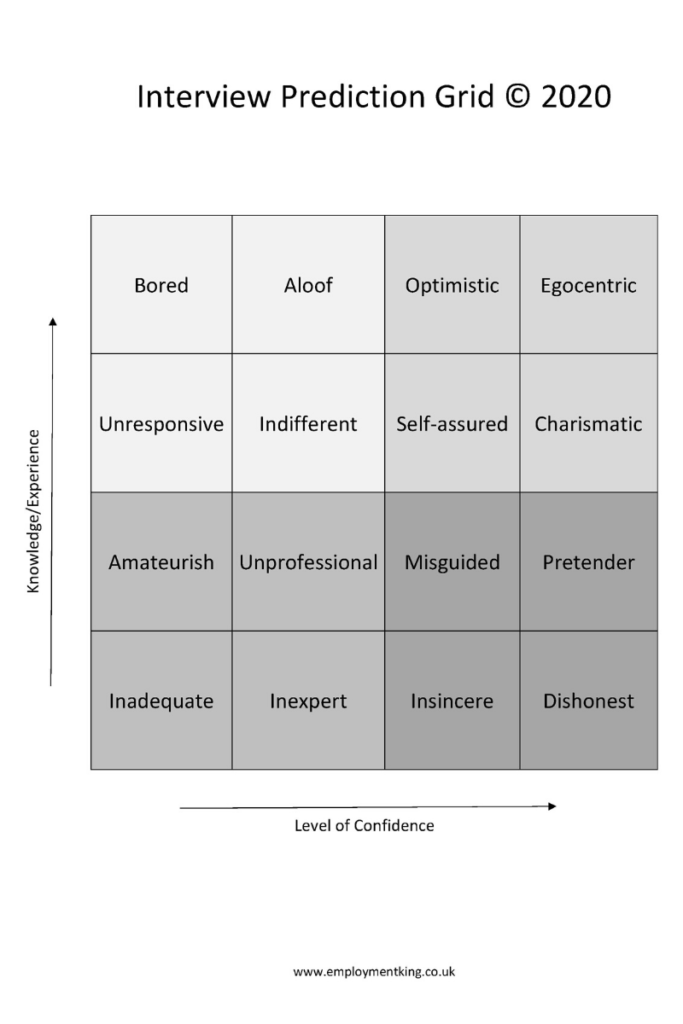
Low/Low; Low Knowledge/Experience and Low Level of Confidence.
2/2 – Inadequate
As the lowest score on the IPG, it is highly unlikely that a 2/2 – inadequate interviewee, coming across as lacking the required criteria (competence and confidence) will be offered a paid position. In fact, many voluntary interviewers, unless they feel they have resources to support a 2/2 – inadequate applicant, will also refuse an offer of unpaid employment, as the employer, due to a lack of rapport, will stop looking for potential and instead will be hoping to terminate the interview at the earliest stage.
2/4 – Inexpert
Showing a lack of experience/knowledge creates a persona of being inexpert. Inexpert, at this level, includes soft skills; communication, teamwork, problem-solving. Voluntary employers may recruit a 2/4 – inexpert, due to the interviewees ‘sufficient’ level of confidence – as this shows potential, only if the pool of applicants is low. Employers will be aware of the interviewee’s nervousness and lack of sector experience, which affects the job interview outcome, but some organisations could be willing to spend time to develop the applicant once employed.
4/2 – Amateurish
The 4/2 – amateurish interviewee may highlight their ‘sufficient’ level of knowledge/experience (at this level of job role the knowledge/experience includes soft skills; communication, teamwork, problem-solving) during the job interview question and answer process, but each answer is delivered in an unskilled way, due to a low level of confidence. The employer will get a gist of the meaning of their answer but, depending on how the answer has been delivered (often lacking substance), the meaning will often be misunderstood creating the impression of ‘amateurish.’ A ‘cold’ interview will further reduce the applicant’s confidence which can result in a poor interview performance.
4/4 – Unprofessional
Out of all the low/low identities, the 4/4 – unprofessional interviewee is the most likely job applicant, in this segment, to be offered a paid position. But compared to other applicants from the additional three segments, the 4/4 – unprofessional applicant will be seen as a weaker candidate. The employer will be aware of the 4/4 – unprofessional applicants’ knowledge/experience level, as the 4/4 – unprofessional has a ‘sufficient’ level of confidence that allows the interviewee to give a more detailed reply to job interview questions. This detail, allows the interviewer to gain an understanding of the candidate’s strengths and weaknesses. In most recruitment campaigns a 4/4 – unprofessional interviewee will be seen as below the required level of standard for paid employment, but for some large recruitment drives and/or for large organisations and for voluntary employers, who have the time to support a new recruit, the 4/4 – unprofessional interviewee can have a successful interview outcome.
Low/High; Low Knowledge/Experience and High Level of Confidence.
2/6 – Insincere
Confidence is an advantage in a job interview, as referred to in the high/high segment, but when combined with low knowledge/experience, the increased self-assurance can be seen as hollow – you talk the talk but can you walk the walk? Often ‘medium’ confident individuals will make up for their lack of knowledge/experience by increasing verbal communication without making reference to the job criteria, confusing the interviewer. Unlike their ‘high’ confident counterpart, who can use their persona to influence the interview outcome with a non-expert interviewer, the 2/6 – insecure interviewee doesn’t have the required level of confidence to sway the interviewers opinion. This is because their lack of knowledge/experience puts them on the back foot and this realization can reduce their confidence during the job interview itself. Depending on the interviewer, the ‘medium’ confidence level is enough to secure some job offers above the low skilled job level, but in most cases, the lack of expertise results only in low skilled positions.
2/8 – Dishonest
Possessing the highest level of confidence and the lowest level of knowledge/experience increases verbal diarrhea. The distance between the two axes; low knowledge/experience and high levels of confidence, sends off warning signals to the employer, creating the feeling of distrust. The 2/8 dishonest interviewee will answer interview questions quickly, assertively and confidently, to cover up their lack of knowledge/experience, but this approach comes across as false, especially if the applicant states confidently that they possess a skill/experience that they don’t have. As we have discussed, self-promotion and rapport building influences the job interview, and hiring decisions are often based on initial impressions, with this in mind a 2/8 dishonest interviewee can be viewed to be more employable than they actually are, especially if the interviewee isn’t an ‘expert’. The overconfident interviewee may believe they would be an asset to any organisation but without having a higher level of expertise it is unlikely, but not impossible, that they would be offered any position above a low skilled role, due to the scoring system of the structured job interview.
4/6 – Misguided
The interview process is designed to uncover the interviewee’s strengths and weaknesses, through a series of questions. With a ‘sufficient’ level of experience/knowledge and a ‘medium’ level of confidence, the 4/6 – misguided applicant can often believe, due to the ‘medium’ confidence level, that they are entitled to a higher-level position. This belief is unwarranted, as many other interview identities possess the same or higher level of confidence along with a higher level of expertise. A 4/6 – misguided interviewee may have had previous successes winning low-skilled positions (as a ‘medium’ level of confidence can increase job offers, especially against ‘sufficient’ confident level applicants), but employers recruiting medium-skilled workers demand a particular set of essential criteria. It is often the lack of ability to identify the job criteria, and therefore present the relevant skills embedded within the job interview answer(s), that is the downfall for a 4/6 – misguided applicant applying for any role above a low skilled position.
4/8 – Pretender
Being self-assured, especially in a job interview, is a positive attribute as it increases self-promotions, but there is a fine line between a high level of confidence and being overbearing. Most 4/8 – pretender interviewees believe they should be offered the position, as they possess ‘sufficient’ sector knowledge/experience and, due to high levels of confidence (or in most cases overconfidence) believe they can learn what they don’t already know. Being overconfident in the correctness of their interview answers can ruin the applicant’s job chances, especially is the interviewer is an ‘expert’ in their field. Against other low/high applicants and for low skilled roles, the 4/8 – pretender will often be triumphant in the job interview, but against confident interviewees with more industry knowledge, they are unlikely to be successful. The 4/8 – pretender, when applying for medium-skilled positions, will claim to know more about the role/sector without being able to back this up with evidence. A trained interviewer will spot the lies through the question and answer process, but an inexperienced interviewer may be duped, due to the candidate’s assertiveness and presence, into recruiting an unsuitable staff member.
High/Low; High Knowledge/Experience and Low Level of Confidence.
6/2 – Unresponsive
The lack of confidence for a 6/2 – unresponsive interviewee outweighs their ‘medium’ level of knowledge/experience, leading to short snappy answers that lack detail. Some employers will encourage the interviewee throughout the question and answer process, and even hint that they require more information, but the anxiety of a job interview can result in a poor performance that will make the interviewer remember them for the wrong reasons “we gave them every chance to answer the interview questions.” Many interviewers will create a bias at the interview start based on the candidate’s obvious nervousness that will influence the hiring decision. It is the 6/2 – unresponsive interviewees consistent lack of good answers that results in regular job offer rejections. Against more confident high/low applicants applying for medium-level positions, the 6/2 – unresponsive interviewee will often fail unless they possess a unique desirable skill that they can express during the job interview. It is the lack of confidence that results in the 6/2 – unresponsive sometimes working in positions below their level of knowledge/experience.
6/4 – Indifferent
Possessing a ‘medium’ level of knowledge/experience makes an applicant more employable as the candidate can identify the required criteria for the desired position. A ‘sufficient’ level of confidence allows some ‘good’ answers to come through, highlighting the applicant’s knowledge/experience, but this level of quality answer is sporadic. The result of the sporadic level of quality answers, when answering job interview questions, comes across as if the 6/4 – indifferent interviewee isn’t interested in the position they are applying for, as the applicant answers some questions with detail and others with, from the employer’s viewpoint, a lack of effort/interest. The 6/4 – indifferent applicant can have success if the ‘good answers’ are for the key criteria job interview questions. 6/4 – indifferent interviewee often performs well when all the interview questions relate easily to their direct experience, but when the questions are framed outside of their area of expertise, they struggle to reply confidently which affects the employers perspective of their employability value.
8/2 – Bored
Interviewers can sense when an applicant has high levels of K/E (in this case the highest level of K/E within the high/low segment) as sector terminology, industry references, and specific details used by the applicant gives unconscious clues to the interview panel. But the low level of confidence for an 8/2 – bored interviewee can come across as though they aren’t interested in the position, even though they are. This perceived lack of interest kills the likability factor which will influence the job interview outcome. It is often the monotone voice with an unchanging pitch and/or the short snappy answers which creates this negative illusion. It is rare for an employer to recruit such an employee for a ‘medium’ level position, as they believe that anyone who is ‘bored’ in a job interview will surely be bored if they were offered the position. Many employers will recognise that the interviewee is lacking in confidence and will support the applicant throughout the interview, requesting for more details and/or examples, but if the nervous applicant fails to state the required criteria for the job role, the interviewer has little choice but to mark them low on the interview scorecard.
8/4 – Aloof
A cool and distant interviewee, created through a ‘high’ knowledge/experience and ‘sufficient’ confidence level, can be viewed as distant. The 8/4 – aloof applicant is the highest scorer in the high/low segment, with some 8/4 – aloof career professionals looking to move from medium level positions to high level roles (or high paid medium level jobs) At this level of job role, the interviewers are likely to be experts and therefore are likely to have high levels of confidence in their ability. We know from research that interviewees will receive more job offers when the interviewer finds commonality with the applicant. If the applicant being interviewed by a confident interviewer, themselves lack confidence, rapport will be broken. Employers are looking for a new team member that will ‘fit-in’ with the team dynamics and the company culture. Anyone who sits outside of this image; the aloof applicant, can be viewed as potentially harmful if allowed to join a current group of motivated employees (especially in managerial roles) The 8/4 – aloof applicant, because they possess a ‘sufficient’ level of confidence can give enough detail to interview questions, allowing the employer to be aware of their ‘high’ level of knowledge/experience. But each answer lacks the specifics and/or a confident delivery that decreases the likability factor, creating a sense of ‘distance’ between the applicant and interviewer. The employer will put the lack of detailed answers down to nervousness or character, but when applying for high paid medium level positions, organisations are expecting applicants to have the communication skills and confidence levels to be able to express themselves clearly.
High/High; High Knowledge/Experience and High Level of Confidence.
6/6 – Self-assured
All high/high interviewees are employable. The 6/6 – self-assured applicant will easily build rapport with a job interviewer as their ‘medium’ confidence level and knowledge/experience is expressed with industry-related anecdotes and detailed examples. Being ‘medium’ in both knowledge/experience and level of confidence, the 6/6 – self-assured individual is aware of their own abilities and expresses this well. Within the high/high segment, the 6/6 – self-assured applicant is the lowest high/high quadrant, but this does not always mean they will be unsuccessful against other high/high interviewees as some applicants with an 8-level of confidence can overplay their hand. But the reality is that a 6/6 self-assured career professional is often at the beginning of their senior-level career, applying for roles against other, more experienced, high/high applicants.
6/8 – Charismatic
Interviewers have a hard time when all applicants are high/high candidates. With each interviewee having ‘medium’ to ‘high’ knowledge/experiences, it is often the smallest of things that can change the job interview outcome. Decisions are made at the emotional level, not logically. It is this reason why the 6/8 – charismatic applicant can have, in some interviews, an advantage over the 8/6 -optimistic interviewee. Their ‘medium’ rather than ‘high’ level of knowledge/experience, twinned with their ‘high’ level of confidence creates a charming effect. The ‘medium’ knowledge/experience means that not every answer if perfect. This lack of perfection, combined with a natural confident delivery, increases rapport as the illusion of vulnerability and/or authenticity is created. Interviewers, due to making emotional decisions, buy-in to the individual, not the polished, faultless, and often robotic presentation of other high/high applicants. 6/8 – charismatic applicants have to be careful not to fall into the trap of sticking to their guns when challenged by an expert interviewer on a particular point they themselves are not an expert in, as this lack of high levels of knowledge/experience along with an argumentative approach (due to having a high level of confidence) can break the charismatic spell.
8/6 – Optimistic
Often 8/6 – optimistic career professionals will possess over 10 yrs industry experience; they are experts in their field but humble enough not over-egg their high-level skill set, experiences and unique selling point, due to being a ‘medium’ confidence level rather than a ‘high’, as we will see with the 8/8 – egocentric. Of all 16 interview identities, the 8/6 – optimistic is more likely to be consistent with receiving job offers. The employability factor comes down to having specialist skills and knowledge gained over a vast period of time (high level of knowledge/experience) and being able to identify the job criteria. It is unlikely that the 8/6 – optimistic interviewee won’t have an example or two to each asked interview question. Further, they are able to state sector models, theories, and give additional information that will add value while informing the interview panel (an example would be how the increase/decrease of the global economy will impact their sector.) Interviewers will often be impressed with the 8/6 – optimistic presence; as they come across calm, collected, and confident, without being too overbearing.
8/8 – Egocentric
Possessing both high knowledge/experience and level of confidence doesn’t always make the 8/8 – egocentric applicant the most likely interviewee to gain an offer of employment. In fact, their overconfidence in their ability (which is likely to be true due to having, on average over 10yrs+ industry experience and a specialist skillset) comes across as domineering, compared to the 8/6 – charismatic applicant. The extreme 8/8 – egocentric truly believe they are better than other interviewees and often the interviewers themselves, and will show off their knowledge/experience throughout the job interview, even arguing over a minor point with the employer. On the interview score-sheet, the 8/8 – egocentric interviewee scores high, as they genuinely have experiences/knowledge that would add value to an organisation. 8/8 – egocentric, at the extreme can be narcissistic; they will self-promote which increases a positive job interview outcome, but they won’t back down on a point they have made even when presented with contradictory evidence. As alluded to previously, decisions are made emotionally, not logically. If purely a logical decision, the 8/8 – egocentric career professional would, in most cases, be offered the position, but as some interviewers feel threatened by the overbearing 8/8 – egocentric and/or feel annoyed by their self-centered appearance, the emotional judgment of an interviewer plays a large part in the interview scoring process.
Summary
The article set out to increase interviewees’ awareness of the psychology in play during the job interview, including unconscious bias, and how they, due to their level of knowledge/expertise and level of confidence, are viewed by the interviewer through an ‘interview identity.’
Research has shown how first impressions created by the interviewee’s communication, appearance, and confidence levels affect the interviewer’s judgment creating a filter or bias that affects the job interview outcome. Possessing a high level of knowledge/experience alone is not enough to increase job offers. Confidence, often highlighted through self-promotion is seen as ‘positive’ in the job interview (even expected). Confidence, which improves likeability, will increase the prospect of a successful interview but alone this isn’t enough as research shows how being able to identify job criteria (which comes from having high levels of knowledge/experience) improves interview performance, as answers relate directly to the scoring requirements on the scorecard. It is a combination of medium to high levels of knowledge/experience and confidence that increases the likelihood of potential job offers.
The ‘Interview Prediction Grid’ (IPG) ©2020 model aims to support interviewees to understand how the interviewer perceives them in the job interview (via a job interview identity) and therefore allowing the interviewee to improve their ‘interview identity’ increasing job offers. A final element to reflect on, is that the interviewer themselves impact the interviewee’s performance, especially when the interviewer is either a ‘cold’ or an ‘expert’ interviewer.
References
Bernieri, Frank. (2000). The importance of first impressions in a job interview.
Ingold, P., Kleinmann, M., König, C., Melchers, K. and Van Iddekinge, C., 2014. Why do Situational Interviews Predict Job Performance? The Role of Interviewees’ Ability to Identify Criteria. Journal of Business and Psychology, 30(2).
SIMONS, T., 1995. Interviewing job applicants? How to get beyond first impressions. The Cornell Hotel and Restaurant Administration Quarterly, 36(6).
Klehe, U. and Latham, G., 2006. What Would You Do—Really or Ideally? Constructs Underlying the Behavior Description Interview and the Situational Interview in Predicting Typical Versus Maximum Performance. Human Performance, 19(4).
Liden, R., Martin, C. and Parsons, C., 1993. INTERVIEWER AND APPLICANT BEHAVIORS IN EMPLOYMENT INTERVIEWS. Academy of Management Journal, 36(2).
Powell, Deborah & Feiler, Amanda. (2015). Behavioral Expression of Job Interview Anxiety. Journal of Business and Psychology. in press. 10.1007/s10869-015-9403-z.
RYNES, S. and GERHART, B., 1990. INTERVIEWER ASSESSMENTS OF APPLICANT “FIT”: AN EXPLORATORY INVESTIGATION. Personnel Psychology, 43(1).
Paulhus, D., Westlake, B., Calvez, S. and Harms, P., 2013. Self-presentation style in job interviews: the role of personality and culture. Journal of Applied Social Psychology, 43(10).
Kausel, E., Culbertson, S. and Madrid, H., 2016. Overconfidence in personnel selection: When and why unstructured interview information can hurt hiring decisions. Organizational Behavior and Human Decision Processes, 137.
Meyer, Michael F. “Improving job interview skills.” Healthcare Financial Management, vol. 53, no. 9, Sept. 1999, p. 64+. Gale Academic OneFile, https://link.gale.com/apps/doc/A55834431/AONE?u=ccm_jisc&sid=AONE&xid=4536d0ba. Accessed 23 June 2020.
Pingitore, R., Dugoni, B., Tindale, R. and Spring, B., 1994. Bias against overweight job applicants in a simulated employment interview. Journal of Applied Psychology, 79(6).
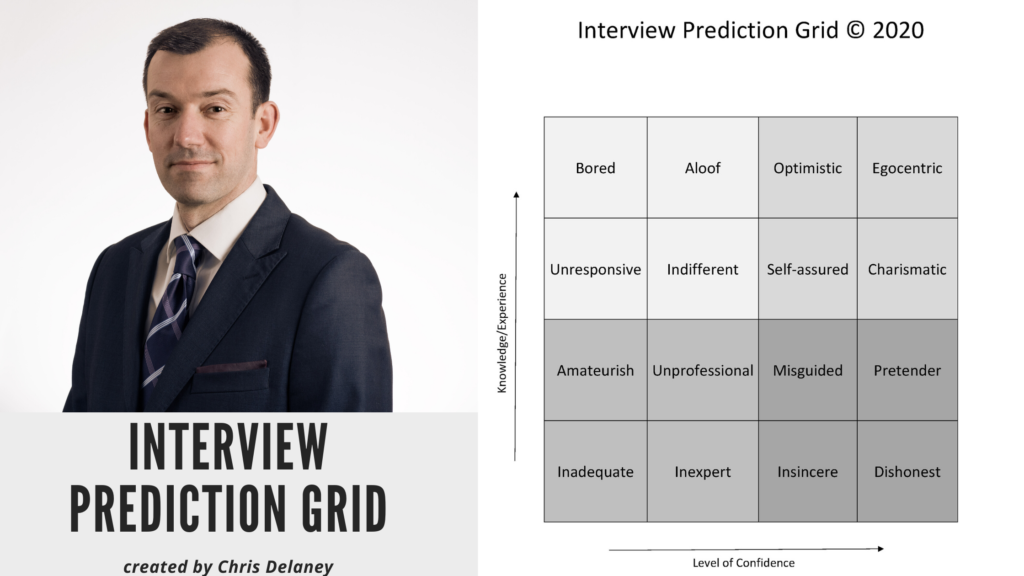
Christopher Delaney is an experience careers advisor and interview coach and published author; The 73 Rules for Influencing the Interview
Job Interview Advice


